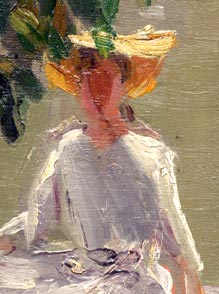 |
THE MEADOW SCENE |
 |
-
Now please turn back to the
Parasol paintings and have a look at the broad, opaque strokes of
the dresses and compare with the ‘Meadow scene’! These kinds of
strokes are typical for Monet’s figure paintings. Again, we find
parallels in some other paintings: “A most distinctive feature of
Impressionist brushwork is the use of the tache, the coloured
patch or stroke. In academic painting, forms could be smoothly
modelled or linear; part of the Impressionist initiative was to
define forms in clearly differentiated patches of colour, which
gave the effect of light surrounding, and reflecting of objects
rather than the specific shapes of the objects themselves. Notable
examples in Monet’s work are the Bathers at La Grenouillère,
The Beach at Trouville, in which the highlights on
Camille’s dress appear to be almost abstract slabs of pale, thick
paint, (Plate see this), and the
Regatta at Argenteuil, 1872 (W 233), in which the whole
scene is captured in broad, opaque strokes of brilliant colour.”,
(Art in the Making, p.92).
We would like to suggest another
‘notable example’: the ‘Meadow scene’!
|

Click
HERE for a comparison of brushwork. |
|

Click
HERE for still another colour and brushwork
comparison. |
-
 Now
please take a close look at the figure in the
boat. Is it not the same masterly treatment of light and shadow
as we can see in the parasoll paintings? See
the sun shining on, and through (!) her hat, on her shoulders,
arms and legs. Observe the shadow from
her hat, falling down at her breast. Now
please take a close look at the figure in the
boat. Is it not the same masterly treatment of light and shadow
as we can see in the parasoll paintings? See
the sun shining on, and through (!) her hat, on her shoulders,
arms and legs. Observe the shadow from
her hat, falling down at her breast.
Please
observe also the curl of her hair at her forehead and the little
glimpse we see of her hair hanging down at her back. Now please
look again at the two Parasol paintings. Where she stands turned
right, we can see a small curl at her forehead, and the hair
hanging down at her back. We also see it through her, under her
arm (remember the ‘looking throughs’ from above?).

Click for comparison
In the other
version we clearly see a small glimpse of the
hair at her neck, just
like at her neck in the ‘River Scene’.
Again – these small characteristics were not painted by chance,
they are, on the contrary, the leading features of the eminent,
observing artist – Claude Monet!

Click for comparison
Perfect balance is achieved by her kerchief, flying
in the wind. We also get a feeling of “déjà vue” when we see the sun
shining at it – isn't it much the same as the sun mingled willow
leaves in the ‘River Scene’?
-
In the
turned-left version, (W
1077), Suzanne stands turned away from the sun. It seems
like the wind is blowing harder. She is protecting herself more
from the wind, than from the sun. The intensive shadow on the
grass, we certainly recognise from our ‘Meadow scene’!
Worth
notifying is also how we can see the sun shining through (!) her
parasol, in a similar way as through the hat in the ‘River scene’,
and, furthermore, we have the same kind of shadow
from the parasol, as from the hat in the ‘River Scene’! Please
have a close look at the parasol and you will also recognise the
same, easy, masterly painted outlines as in Suzanne’s dress and
the table in the ‘Garden scene’.
After having studied all these
details, it is fascinating to make the same study of the details
in the painting ‘Woman
with a parasol’, from 1875, (W381), National
Gallery of Art, Washington, (of which the above are reprises).
Here we have Camille in full shadow with the sun shining from
behind her. It is all there: the Shadow on the grass. The Sun
glitter at her dress. The same outline of the parasol. Compare the
colours in the dress here with the ‘Meadow scene’ and the colours
at the shadow side of the dress.
Press HERE for
next page
|
|